Observational Evidence of Neighborhood Scale Reductions in Air Temperature Associated with Increases in Roof Albedo
Abstract
1. Introduction
2. Methodology
2.1. Areas of Analysis
2.2. Defining Aggregation Areas
2.3. Meteorological Data
2.4. Description and Data Sources for Land Use Land Cover Properties
2.5. Deriving Sensitivities of Measured Air Temperature to LULC Properties
- We first detect and remove outlier weather stations for each hour. This is carried out by first performing a standard least squares linear regression. The influence of each point in determining the regression slope is then computed using leverage and residuals. Based on the distribution of influences for each hour and region, data points that have influence beyond 1.5 times the inner quartile range of the distribution are removed. This tends to eliminate points that have too much influence in determining the final regression statistics. After these points are removed, another regression is carried out. This time we use a robust linear regression with a Huber-T objective function [38]. Regression using the Huber objective function gives higher weights to points with lower residuals, whereas standard regression using least-squares gives equal weights to each observation. The combination of outlier removal and robust regression minimizes the role of observations with high leverage, high residuals, or both. The sensitivity of temperature to the LULC parameter is then computed as the slope of the robust regression (i.e., ).
- Next, we determine whether the computed spatial sensitivity is statistically distinguishable from zero. We do so by computing the probability (“p”) value of the aforementioned robust regression. We deem the hourly sensitivity significant if the p-value is less than 0.1. The choice of this value was rather subjective.
- Lastly, for each hour of the day, we compute the number of days in July with statistically distinguishable sensitivities for each land cover property. Those sensitivities with >10 significant days are deemed as having significant relationships for that hour of the day. Those with ≤10 are deemed insignificant. This threshold was chosen subjectively, but roughly corresponds to half the number of sunny days for this month.
3. Results
3.1. The Sensitivity of Temperature to Solar Power Reflected from Roofs
3.2. The Sensitivity of Temperature to Tree Fraction
3.3. Roof versus Non-Roof Surfaces as Contributors to Variability in Solar Power Reflected from Neighborhoods
4. Discussion
4.1. Comparison with Literature
4.2. Dependence of Reported Temperature-Landcover Sensitivities to Neighborhood Characteristics
4.3. Policy-Relevant Take-Away Points
- Observed air temperature reductions are associated with increases in reflected solar power from roofs. Temperature reductions are larger during the day than at night, and peak in the afternoon. The peak effect is 0.31 °C and 0.49 °C reduction in afternoon air temperature per MW increase in solar power reflected from the neighborhoods in SFV and Central Los Angeles, respectively. To put this in more tangible terms, we can report temperature reductions per roof or overall albedo increase (Table 2). The average daily temperature reductions are 0.25 °C and 1.84 °C per 0.1 increase in roof albedo, which translates to 0.96 °C and 6.56 °C reduction per overall albedo increase of 0.1 for SFV and Central Los Angeles, respectively.
- In Central Los Angeles, variations in solar power reflected from roofs (and thus roof albedo) appear to dominate variations in observed air temperature relative to the effects of tree fractions. Note that this is based on current neighborhood-to-neighborhood variability in tree fraction in this region and should not be interpreted as how future additional tree cover would affect temperatures. For SFV, observations suggest an overnight (00:00–07:00 LDT) temperature reduction of up to about 1.5 °C per 0.1 increase in tree fraction.
- As with any observational studies, we are correlating temperature and land use/land cover parameters. Thus, we cannot make definite conclusions about causation. However, we have hypothesized and provided evidence for appreciable temperature reductions at the neighborhood-scale due to increasing reflected solar power through roof albedo increases. To our knowledge, this is the first study to provide observational evidence of roof albedo increases being associated with temperature reductions.
5. Summary
Supplementary Materials
Author Contributions
Funding
Acknowledgments
Conflicts of Interest
References
- Oke, T.R. City size and the urban heat island. Atmos. Environ. 1973, 7, 769–779. [Google Scholar] [CrossRef]
- Sun, C.Y.; Brazel, A.J.; Chow, W.T.L.; Hedquist, B.C.; Prashad, L. Desert heat island study in winter by mobile transect and remote sensing techniques. Theor. Appl. Climatol. 2009, 98, 323–335. [Google Scholar] [CrossRef]
- Santamouris, M. Cooling the cities—A review of reflective and green roof mitigation technologies to fight heat island and improve comfort in urban environments. Sol. Energy 2014. [Google Scholar] [CrossRef]
- Taha, H. Meteorological, emissions, and air-quality modeling of heat-island mitigation: Recent findings for California, USA. Int. J. Low Carbon Technol. 2013, 10, 3–14. [Google Scholar] [CrossRef]
- Sailor, D.; Shepherd, M.; Sheridan, S.; Stone, B.; Kalkstein, L.; Russell, A.; Vargo, T.; Andersen, T. Improving heat-related health outcomes in an urban environment with science-based policy. Sustainability 2016, 8, 1015. [Google Scholar] [CrossRef]
- Voogt, J.A.; Oke, T.R. Effects of urban surface geometry on remotely-sensed surface temperature. Int. J. Remote Sens. 1998, 19, 895–920. [Google Scholar] [CrossRef]
- Pomerantz, M.; Akbari, H.; Berdahl, P.; Konopacki, S.J.; Taha, H.; Rosenfeld, A.H. Reflective surfaces for cooler buildings and cities. Philos. Mag. B 1999, 79, 1457–1476. [Google Scholar] [CrossRef]
- Peng, S.; Piao, S.; Ciais, P.; Friedlingstein, P.; Ottle, C.; Bréon, F.M.; Myneni, R.B. Surface urban heat island across 419 global big cities. Environ. Sci. Technol. 2012, 46, 696–703. [Google Scholar] [CrossRef]
- Oke, T.R. The energetic basis of the urban heat island. Q. J. R. Meteorol. Soc. 1982, 108, 1–24. [Google Scholar] [CrossRef]
- Kusaka, H.; Kondo, H.; Kikegawa, Y.; Kimura, F. A simple single-layer urban canopy model for atmospheric models: Comparison with multi-layer and slab models. Bound.-Lay. Meteorol. 2001, 101, 329–358. [Google Scholar] [CrossRef]
- Vahmani, P.; Ban-Weiss, G. Climatic consequences of adopting drought tolerant vegetation over Los Angeles as a response to California drought. Geophys. Res. Lett. 2016, 43, 8240–8249. [Google Scholar] [CrossRef]
- Vahmani, P.; Sun, F.; Hall, A.; Ban-Weiss, G. Investigating the climate impacts of urbanization and the potential for cool roofs to counter future climate change in Southern California. Environ. Res. Lett. 2016, 11. [Google Scholar] [CrossRef]
- Taha, H. Urban climates and heat islands: Albedo, evapotranspiration, and anthropogenic heat. Energy Build. 1997, 25, 99–103. [Google Scholar] [CrossRef]
- Zhou, D.; Zhao, S.; Liu, S.; Zhang, L.; Zhu, C. Surface urban heat island in China’s 32 major cities: Spatial patterns and drivers. Remote Sens. Environ. 2014, 152, 51–61. [Google Scholar] [CrossRef]
- Imhoff, M.L.; Zhang, P.; Wolfe, R.E.; Bounoua, L. Remote sensing of the urban heat island effect across biomes in the continental USA. Remote Sens. Environ. 2010, 114, 504–513. [Google Scholar] [CrossRef]
- Taha, H. Characterization of urban heat and exacerbation: Development of a heat island index for California. Climate 2017, 5, 59. [Google Scholar] [CrossRef]
- Klok, L.; Zwart, S.; Verhagen, H.; Mauri, E. The surface heat island of Rotterdam and its relationship with urban surface characteristics. Resour. Conserv. Recycl. 2012, 64, 23–29. [Google Scholar] [CrossRef]
- Yan, H.; Fan, S.; Guo, C.; Hu, J.; Dong, L. Quantifying the impact of land cover composition on intra-urban air temperature variations at a mid-latitude city. PLoS ONE 2014, 9. [Google Scholar] [CrossRef]
- Sailor, D.J. Simulated Urban Climate Response to Modifications in Surface Albedo and Vegetative Cover. J. Appl. Meteorol. 1995. [Google Scholar] [CrossRef]
- Ohashi, Y.; Genchi, Y.; Kondo, H.; Kikegawa, Y.; Yoshikado, H.; Hirano, Y. Influence of Air-Conditioning Waste Heat on Air Temperature in Tokyo during Summer: Numerical Experiments Using an Urban Canopy Model Coupled with a Building Energy Model. J. Appl. Meteorol. Climatol. 2007, 46, 66–81. [Google Scholar] [CrossRef]
- Salamanca, F.; Georgescu, M.; Mahalov, A.; Moustaoui, M.; Wang, M. Anthropogenic heating of the urban environment due to air conditioning. J. Geophys. Res. Atmos. 2014, 119, 5949–5965. [Google Scholar] [CrossRef]
- Zhang, J.; Mohegh, A.; Li, Y.; Levinson, R.; Ban-Weiss, G.A. Systematic Comparison of the Influence of Cool Wall versus Cool Roof Adoption on Urban Climate in the Los Angeles Basin. Environ. Sci. Technol. 2018, 52, 11188–11197. [Google Scholar] [CrossRef]
- Li, D.; Bou-Zeid, E.; Oppenheimer, M. The effectiveness of cool and green roofs as urban heat island mitigation strategies. Environ. Res. Lett. 2014, 9. [Google Scholar] [CrossRef]
- Lynn, B.H.; Carlson, T.N.; Rosenzweig, C.; Goldberg, R.; Druyan, L.; Cox, J.; Civerolo, K. A modification to the NOAH LSM to simulate heat mitigation strategies in the New York City metropolitan area. J. Appl. Meteorol. Climatol. 2009, 48, 199–216. [Google Scholar] [CrossRef]
- Georgescu, M.; Mahalov, A.; Moustaoui, M. Seasonal hydroclimatic impacts of Sun Corridor expansion. Environ. Res. Lett. 2012, 7. [Google Scholar] [CrossRef]
- Millstein, D.; Menon, S. Regional climate consequences of large-scale cool roof and photovoltaic array deployment. Environ. Res. Lett. 2011, 6. [Google Scholar] [CrossRef]
- Zhang, J.; K Zhang, K.; Liu, J.; Ban-Weiss, G.A. Revisiting the climate impacts of cool roofs around the globe using an Earth system model. Environ. Res. Lett. 2016, 11, 084014. [Google Scholar] [CrossRef]
- Mohegh, A.; Rosado, P.; Jin, L.; Millstein, D.; Levinson, R.; Ban-Weiss, G. Modeling the climate impacts of deploying solar reflective cool pavements in California cities. J. Geophys. Res. 2017, 122, 6798–6817. [Google Scholar] [CrossRef]
- Mackey, C.W.; Lee, X.; Smith, R.B. Remotely sensing the cooling effects of city scale efforts to reduce urban heat island. Build. Environ. 2012, 49, 348–358. [Google Scholar] [CrossRef]
- Los Angeles Building Code. Available online: http://www.ladbs.org/docs/default-source/publications/code-amendments/2017-l-a-amendment-to-ca-codes.pdf?sfvrsn=8 (accessed on 1 September 2016).
- CEC. 2016 Building Energy Efficiency Standards for Residential and Nonresidential Buildings; Publication CEC-400-2015-037-CMF; California Energy Commission: Sacramento, CA, USA, 2016. Available online: http://www.energy.ca.gov/2015publications/CEC-400-2015-037/CEC-400-2015-037-CMF.pdf (accessed on 1 May 2017).
- WunderGround API. A Weather API Designed for Developers. Available online: https://www.wunderground.com/weather/api (accessed on 1 September 2016).
- NOAA. Land-Based Station Data–National Climatic Data Center–NOAA. Available online: https://www.ncdc.noaa.gov/data-access/land-based-station-data (accessed on 1 September 2016).
- LARIAC. Countywide Building Outlines. 2008. Available online: https://egis3.lacounty.gov/dataportal/2011/04/28/countywide-building-outlines/ (accessed on 1 November 2016).
- CAMS. LA County Street & Address File. 2011. Available online: https://egis3.lacounty.gov/dataportal/2014/06/16/2011-la-county-street-centerline-street-address-file/ (accessed on November 2016).
- CARB. Life-Cycle Assessment and Co-Benefits of Cool Pavements. 2017. Available online: https://www.arb.ca.gov/research/apr/past/12-314.pdf (accessed on 20 September 2017).
- Ban-Weiss, G.A.; Woods, J.; Levinson, R. Using remote sensing to quantify albedo of roofs in seven California cities, Part 1: Methods. Sol. Energy 2015, 115, 777–790. [Google Scholar] [CrossRef]
- Huber, P.J. Robust Statistics; John Wiley and Sons: New York, NY, USA, 1981. [Google Scholar]
- Taha, H.; Levinson, R.; Mohegh, A.; Gilbert, H.; Ban-Weiss, G.; Chen, S. Air-temperature response to neighborhood-scale variations in albedo and canopy cover in the real world: Fine-resolution meteorological modeling and mobile temperature observations in the Los Angeles climate archipelago. Climate 2018, 6, 53. [Google Scholar] [CrossRef]
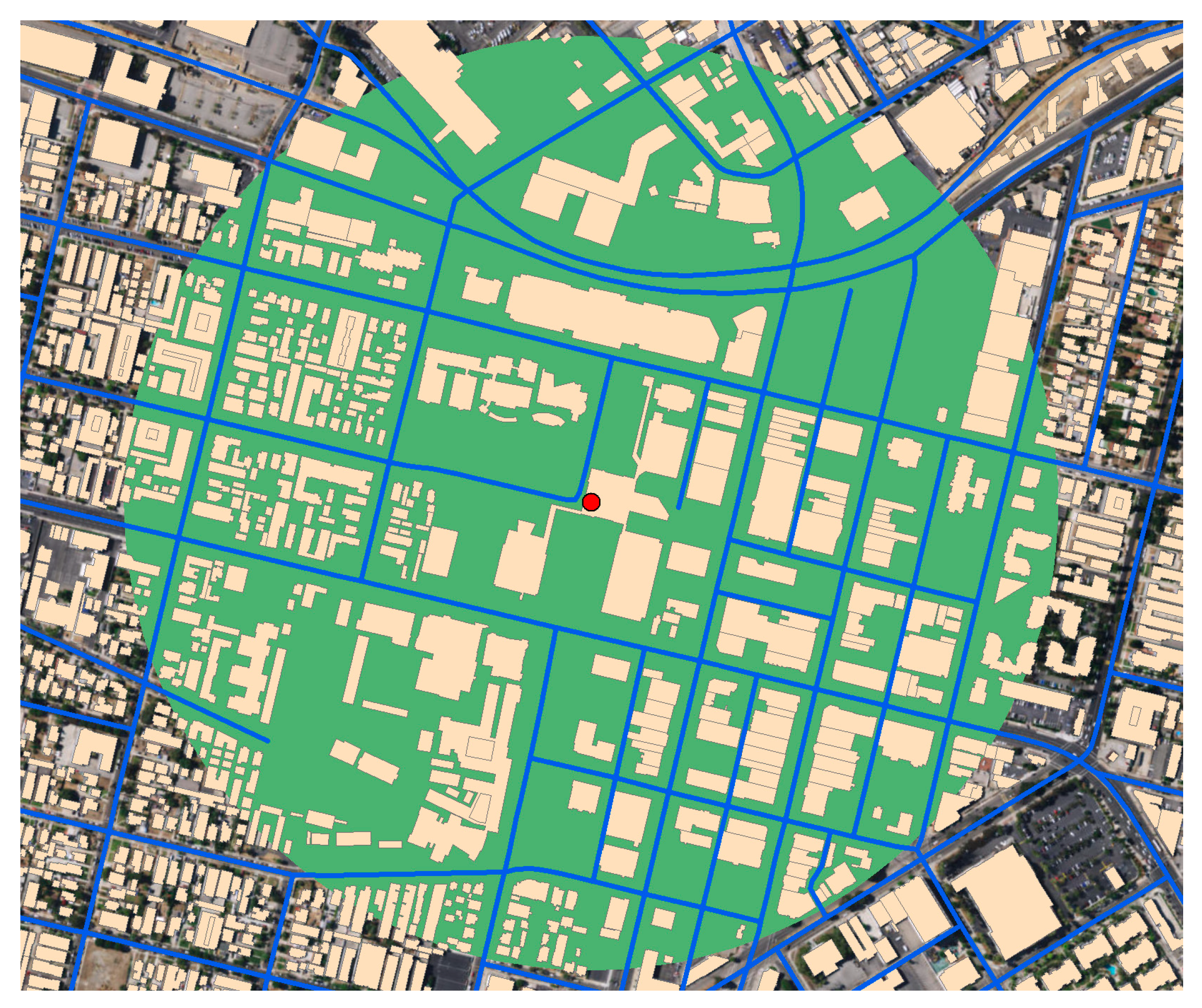
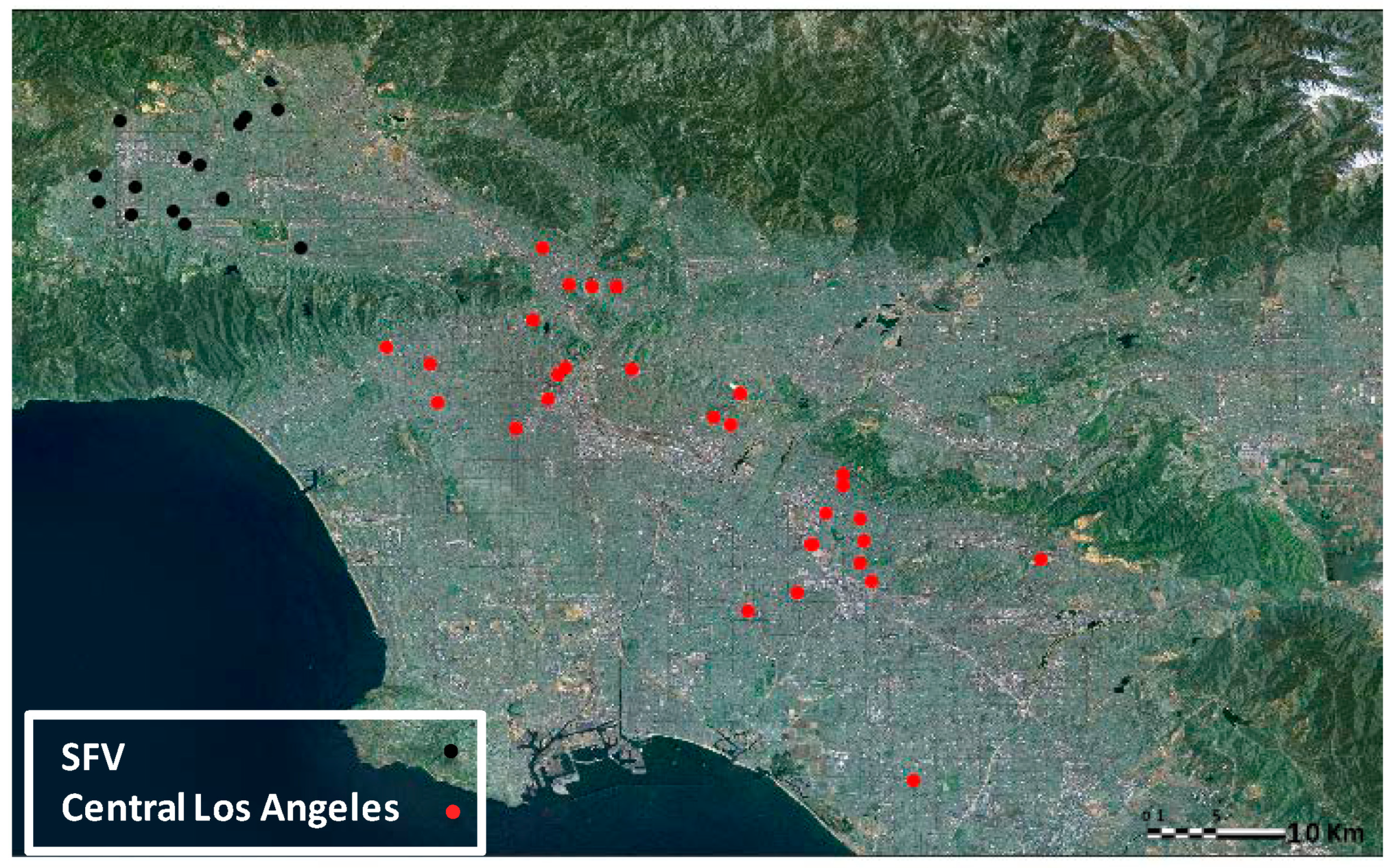
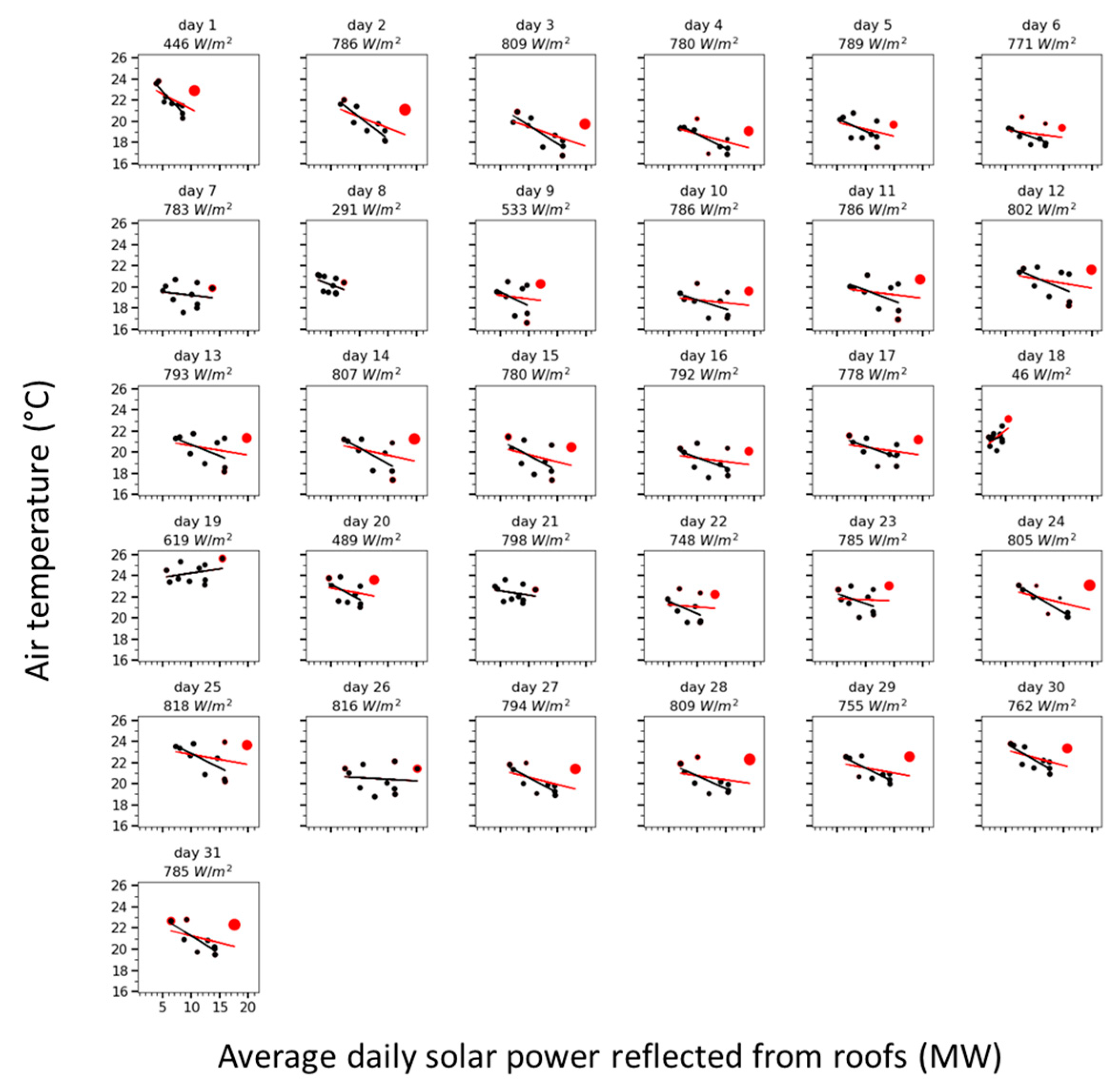
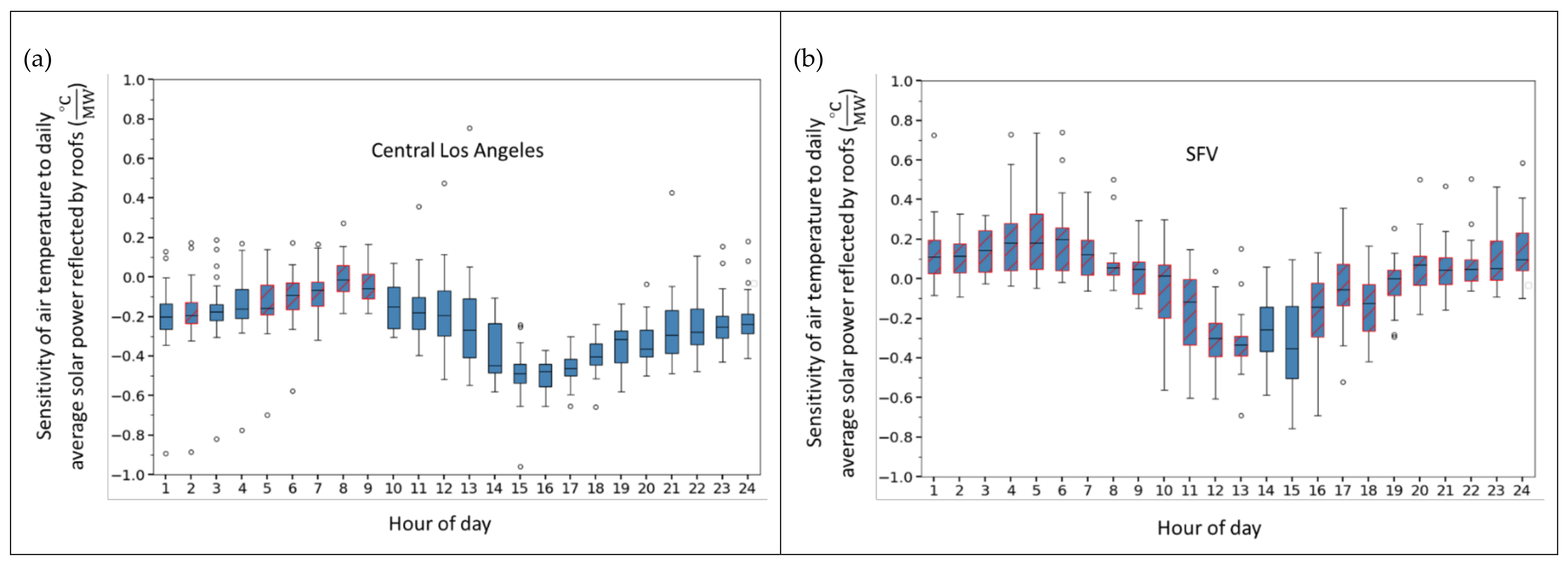
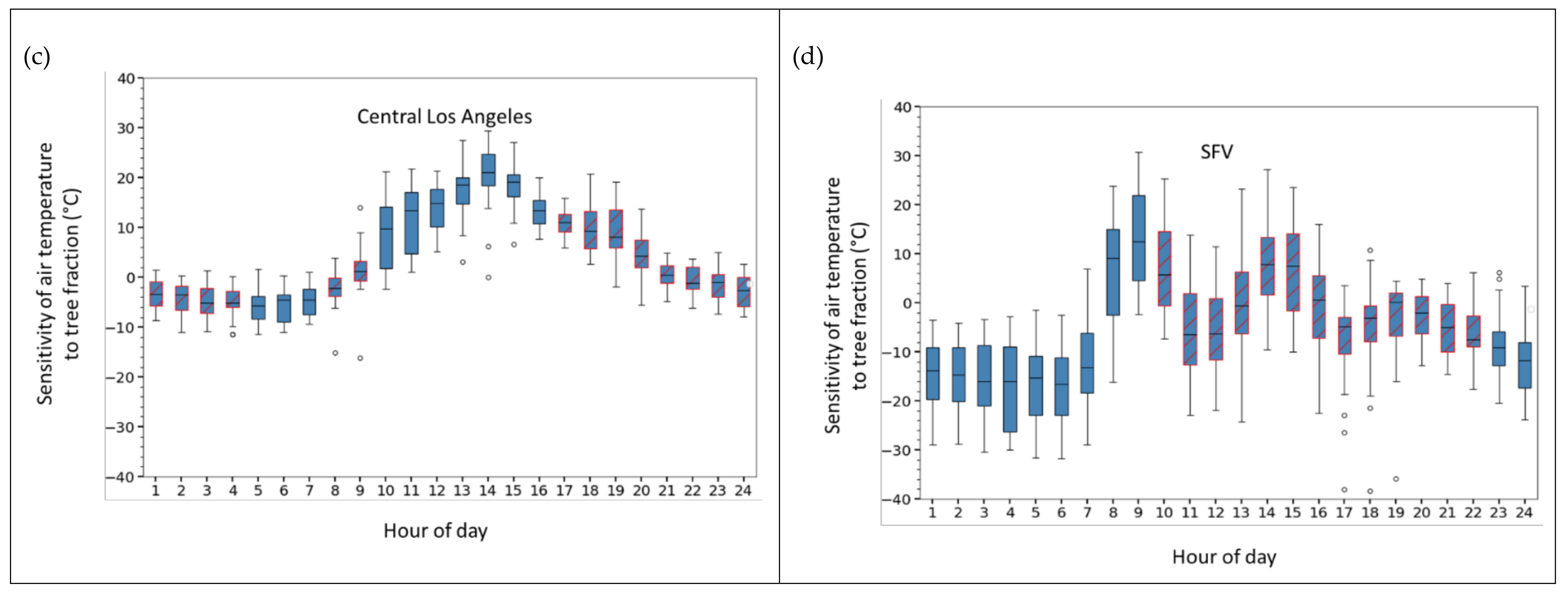
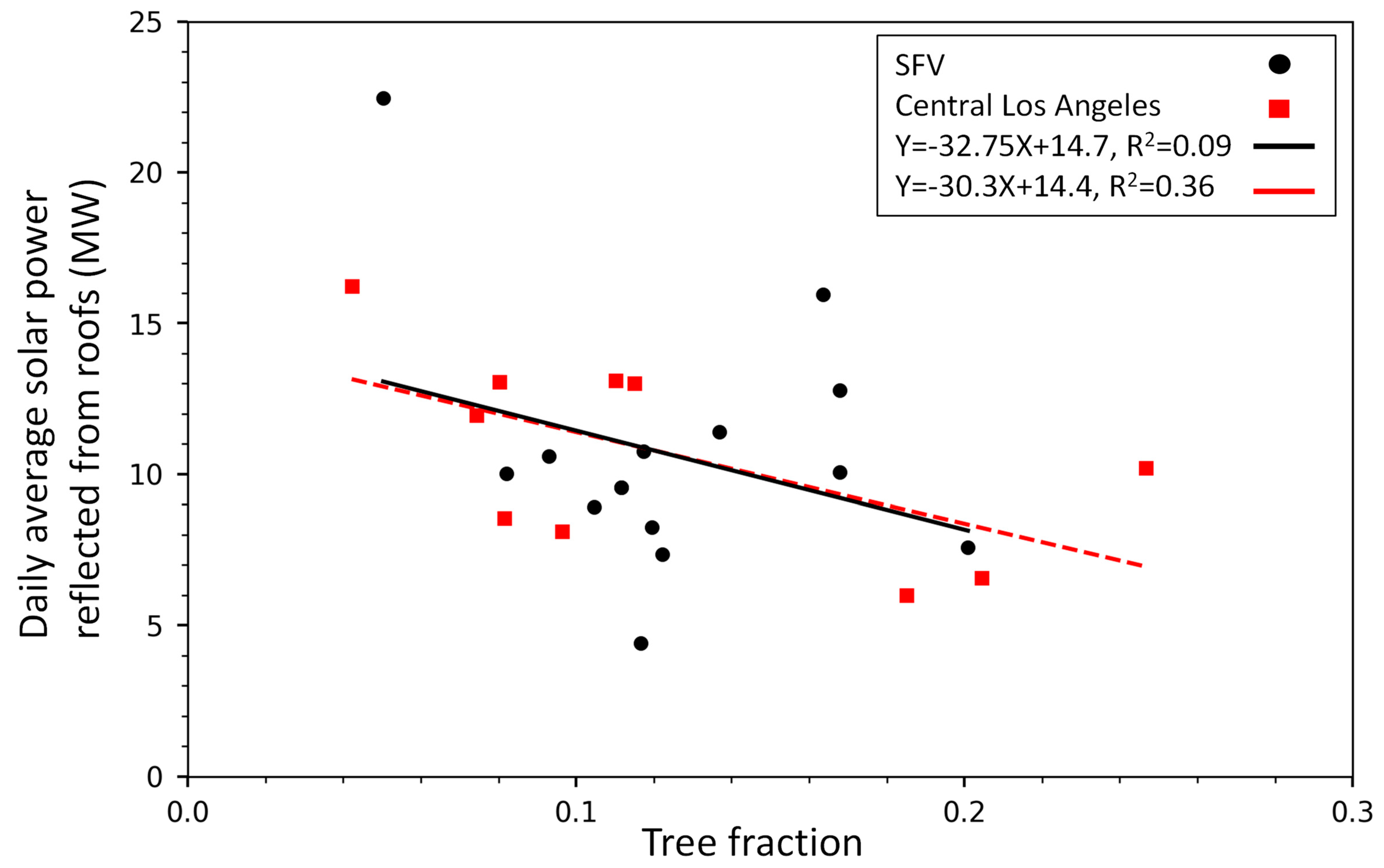
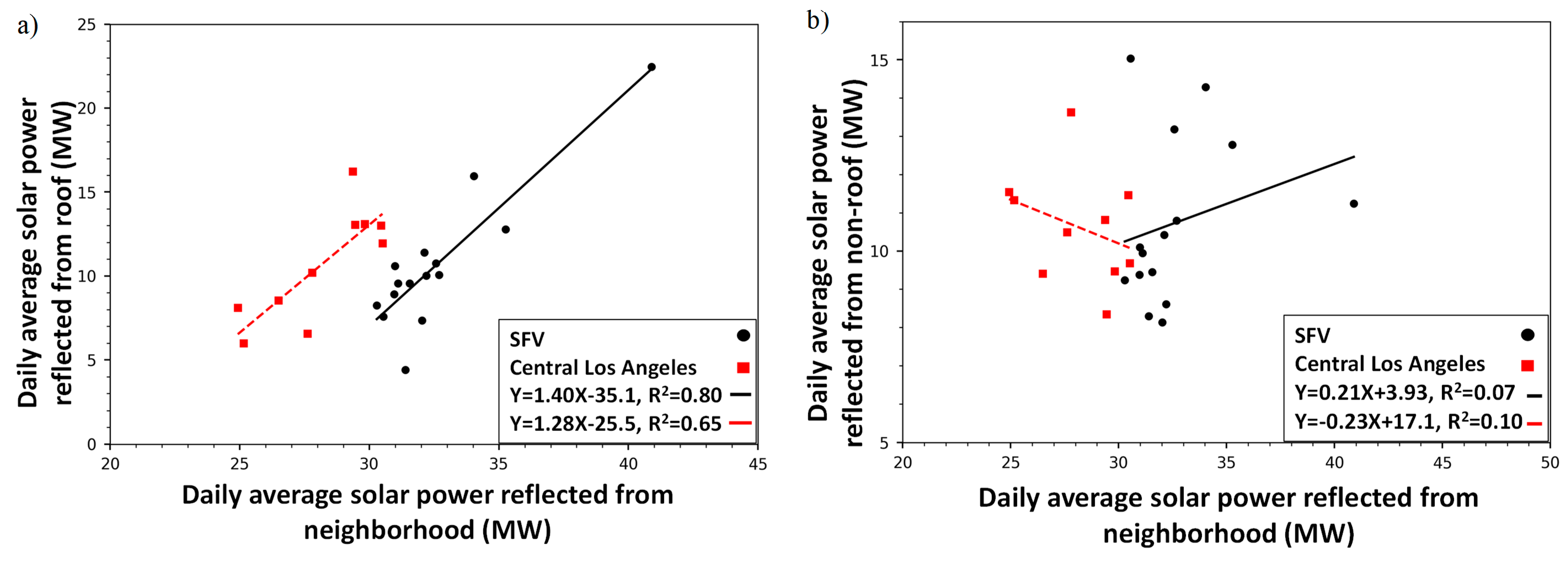
| Daily Minimum Temperature (°C) | Daily Maximum Temperature (°C) | Daily Mean Temperature (°C) | Diurnal Temperature Range (°C) | Mean (Standard Deviation) Building Height (m) | Mean (Standard Deviation) Tree Fraction | Mean (Standard Deviation) Roof Fraction | |
|---|---|---|---|---|---|---|---|
| SFV | 19.4 | 30.5 | 24.3 | 11.1 | 5.33 (0.49) | 0.12 (0.037) | 0.26 (0.06) |
| Central Los Angeles | 18.9 | 27.7 | 22.5 | 8.8 | 5.20 (2.72) | 0.12 (0.075) | 0.25 (0.09) |
| Area | Daily Average Temperature Reduction per 0.1 Increase in Roof Albedo (°C) | Daily Average Temperature Reduction per 0.1 Increase in Neighborhood Albedo (°C) | Afternoon a Temperature Reduction per 0.1 Increase in Roof Albedo (°C) | Afternoon Temperature Reduction per 0.1 Increase in Neighborhood Albedo (°C) | Notes | |
|---|---|---|---|---|---|---|
| Current study | SFV | 0.25 b | 0.96 b | 0.05 | 0.19 | |
| Current study | Central Los Angeles | 1.84 | 6.56 | 5.52 | 19.7 | Values from a network of weather stations. Afternoon = 14:00–15:00 LDT |
| Santamouris [3] | Various | 0.2 c | 0.3 d | 0.4 c | 0.9 d | Values come from a meta-analysis of previous climate modeling studies. Time of “peak” afternoon temperature reductions vary by study |
| Vahmani et al. [12] | Southern California | 0.35 | 1.84 | Values from climate modeling using the default near-surface air temperature model output. Afternoon = 15:00 LDT | ||
| Zhang et al. [22] | Southern California | 0.06 | 0.34 | 0.09 | 1.03 | Values from climate modeling. Temperatures represent “canyon air temperature” rather than the default near-surface temperature model output. Afternoon = 15:00 LDT |
| Taha et al. [39] | Downtown Los Angeles | 1.0–9.2 | Values from mobile measurements taken at various times of day, with the highest sensitivity derived from 11:00–14:00 LDT. Note that sensitivity values for measurements taken at night fall within the reported range. |
© 2018 by the authors. Licensee MDPI, Basel, Switzerland. This article is an open access article distributed under the terms and conditions of the Creative Commons Attribution (CC BY) license (http://creativecommons.org/licenses/by/4.0/).
Share and Cite
Mohegh, A.; Levinson, R.; Taha, H.; Gilbert, H.; Zhang, J.; Li, Y.; Tang, T.; Ban-Weiss, G.A. Observational Evidence of Neighborhood Scale Reductions in Air Temperature Associated with Increases in Roof Albedo. Climate 2018, 6, 98. https://doi.org/10.3390/cli6040098
Mohegh A, Levinson R, Taha H, Gilbert H, Zhang J, Li Y, Tang T, Ban-Weiss GA. Observational Evidence of Neighborhood Scale Reductions in Air Temperature Associated with Increases in Roof Albedo. Climate. 2018; 6(4):98. https://doi.org/10.3390/cli6040098
Chicago/Turabian StyleMohegh, Arash, Ronnen Levinson, Haider Taha, Haley Gilbert, Jiachen Zhang, Yun Li, Tianbo Tang, and George A. Ban-Weiss. 2018. "Observational Evidence of Neighborhood Scale Reductions in Air Temperature Associated with Increases in Roof Albedo" Climate 6, no. 4: 98. https://doi.org/10.3390/cli6040098
APA StyleMohegh, A., Levinson, R., Taha, H., Gilbert, H., Zhang, J., Li, Y., Tang, T., & Ban-Weiss, G. A. (2018). Observational Evidence of Neighborhood Scale Reductions in Air Temperature Associated with Increases in Roof Albedo. Climate, 6(4), 98. https://doi.org/10.3390/cli6040098





